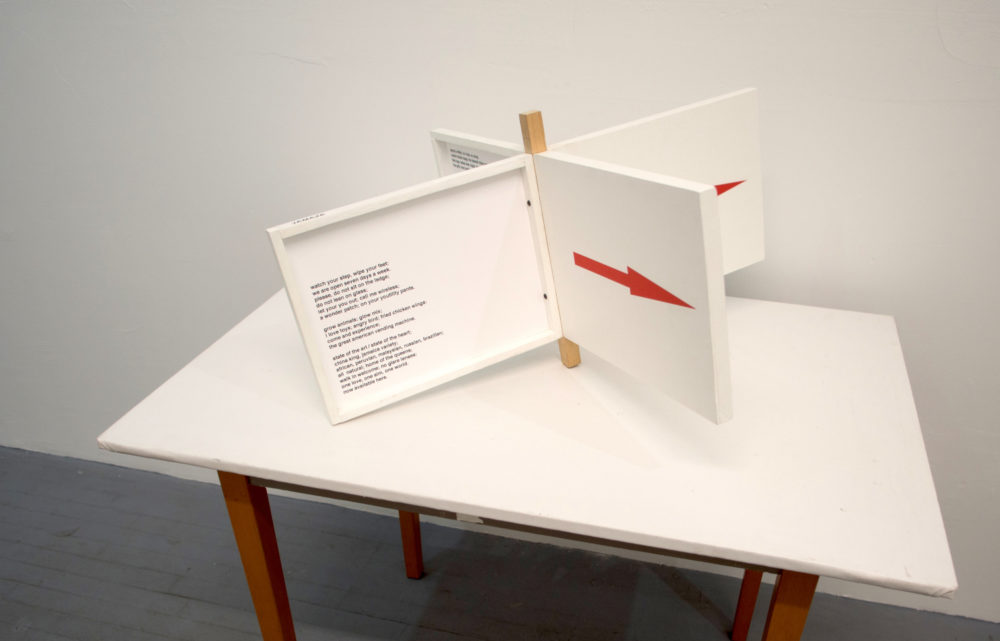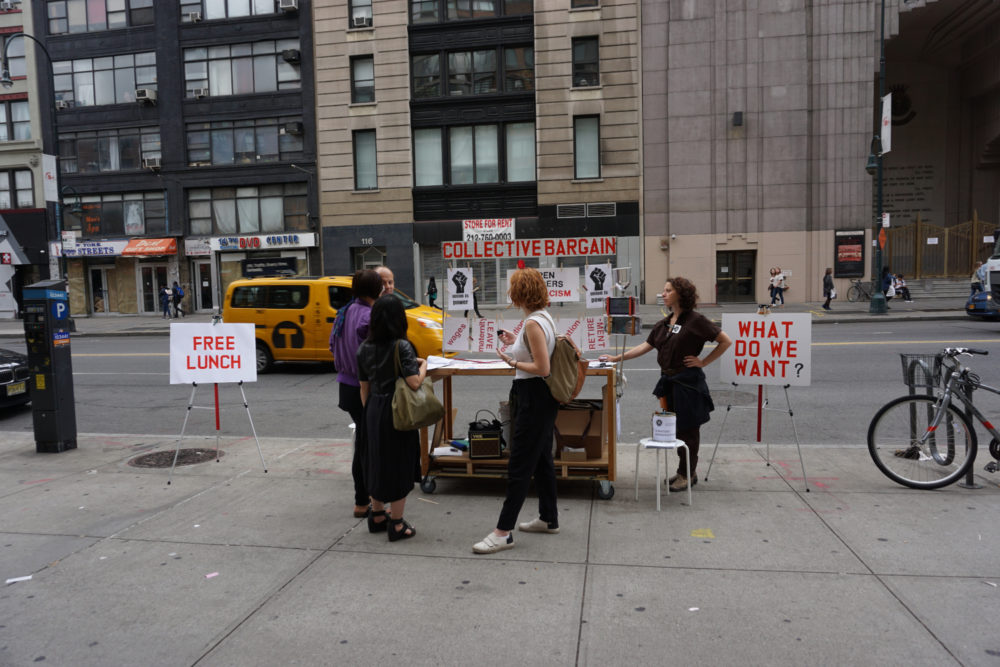jr / YES! This is exactly what I was getting at — the combination of how we make it financially in our artistic practices and how life and art — practice and object — for many — become one and the same. Though you have both come to practice and collaboration differently, the commitment to learning and focus on maintaining a constant practice, while also re-defining that practice, seems to solidify your partnership.
You maintain many websites, identities, organizations, projects — these all serve different purposes yet are linked. They become outlets and spaces for new and exciting conversations — with new movement coming into and throughout your practice. I know there is so much enrichment here. Solidifying projects as organizations or larger ideas brings them to life, provides maximum agency and resounds past any idea or event. But all of these things can also become clutter and potentially a burden. Though it seems you have a very healthy relationship with letting things rest and lie fallow for a bit, does this multitude of activity ever become overly exhaustive — a burden beyond gratitude or payback? Do any of these projects have expiration dates? When do you decide to put something to bed for good? And on the flip-side, when do you know its time to start something new? (Assuming it doesn’t already fall under an existing project’s scope).
“After so many projects together, I believe that we are getting less concerned with thinking only on what is next, but more in trying to adopt more systematic approaches. When we manage to do this more swiftly, we naturally find other partners, supporters, timing and venues for the work.“
— Thiago Szmrecsányi

Poem, inkjet on paper, wood, screws, Approx. 14 in. x 29 in. x 29 in.
Photo: Keka Marzagão
TS / The development of our long term collaboration enabled us to grow our work in multiple directions. We started by sharing a studio, we expanded our perspectives combining our different skills and interests. Building things together made us blend experiences and ideas in an interdisciplinary way. Through practice we engaged in dialogue with audiences that were not exclusively or predominantly artistic. The work platforms that we created comprised art and other outreaching strategies. I think we like to explore a borderline between the real and the fictional or artistic. The more we step on the line or erase the borders between art and non-art, the more inclusive we can be. In this sense, it is a great pleasure for us to count with the inspiration, contribution/collaboration of other artists and non-artists in our initiatives.
Projects can get started for multiple reasons. We usually differ on what is attractive and how to proceed, so we discuss and each one takes a direction and maintains an autonomy pursuing his/her interests. At a late point things collide again and there is a common edition. For me, an exhibition or project does not end on the last day of the event, or on a specific date. Coming back to the studio, I keep working on things that were not resolved to my satisfaction. I try new variations. Sometimes this leads to the transformation of past works into new ones. There is also some undoing in storing and in discarding things. Moreover, entire projects can be relocated/adapted to other sites. With time, the boundaries between the projects also become less clear, and even their names get mixed and confused. Clutter (or what could be a burden) appears in my work more as a result of things that I defer, leave unfinished, or that I feel I do not do very well, than from projects that I am truly committed to. Documenting and promoting the artworks are important things that I would rather leave for others.
As partners, we share the work and divide tasks, yet we still face challenges that are similar to the ones experienced by thousands of other artists. Defining what we want is a step to where we have to go back many times. Recognizing how we operate, our strengths and failures is also part of this process. We know that we do not aspire to be organized as a single and super efficient end oriented productive cell, such as a factory, or a commercial studio so we must use our imagination and experience to make things feel different. After so many projects together, I believe that we are getting less concerned with thinking only on what is next, but more in trying to adopt more systematic approaches. When we manage to do this more swiftly, we naturally find other partners, supporters, timing and venues for the work.

Seen: one of the stops in the 3-day/24-hour circuit of locations and activities on 14th Street in Manhattan. Presented as part of Art in Odd Places: SENSE 2017, curated by Nicolás Dumit Estevez Photo: Courtesy of the Artists
NdC / Most of the time I take on multiple projects at the same time, like having parallel trains running on different tracks. Some of these are collaborative, some are my own “problems”, and others I invite Thiago to join, or pull him in. In some cases, I insert myself in his projects, and thus, create a bigger “problem”. If you are outside, this may seem like a burden; to me it often becomes a nice challenge because I like to solve problems, and I think I usually have my eyes wide open to learning in this process.
For instance, sometimes we both accumulate a lot in our shared studio, thinking it could be useful for something, for different reasons, while working on other projects. It can be for an immediate need, but sometimes it feels like a puzzle or a chess game — it may stay there for a while, even bothering us at times but we don’t get rid of it, because we don’t just abandon the game in the middle of playing it. So it gets to a point that we may store it away to revisit it later, or decide to deal with it right there and then. Something new appears.
This is also a metaphor for our projects: some projects appear out of an opportunity, like a proposal to a festival, and we start fresh with a new idea. Other ideas are recycled for an opportunity we initiate, and they expand or take on different meanings then, with tools or materials already available to be transformed. The main problem I see with the possible overburdening oneself with the types of projects that we do is that its documentation, which sometimes is extremely important for a live performance or a situational project, stays unfinished for a long time. That is another problem to solve! One that I admit that we are both not very good at.
Often, however, it happens because we are curious to jump into another direction already.
With the latest projects, especially over the last 4-5 years, we definitely have expanded our exploration of platforms, instead of works that are more finished onto themselves, as I mentioned before. In the way that they are starting points towards new explorations. Thus, all these explorations feel fresh to me, although they fall into a more extensive umbrella, one that is developed overtime, as it is the case with ART&COM.
The latest projects have not yet rested enough, most probably because they also relate to immediate necessities of collective action. They do get resting breaks though- when one of the other trains starts running faster and it needs more attention. I think it is easier to realize when a project is finished when it is a more individual exploration, such as with performances that have a specific place and time to happen. The exception has really been performance-installations for ART&COM, or under the title of Collective Bargain, for the UAAU, for they are departure points.
As for a burden beyond gratitude and payback, I feel that artists who do not produce for a specific market or commercial idea often have a challenge to not only show the work, but also to not pay themselves a minimum something to make the project feel worthy. I don’t just mean payment as a financial measure of achievement or success. I also mean it in the way of putting the project in the public eye, as sometimes many things don’t even get exposed enough for scrutiny or appreciation. So this measuring of gratitude and payback, at least in my experience, was always challenged by potential measurements of success or failure. I just don’t think that non-profit art or projects always work that objectively. This is probably a big commonality between Thiago and I: if we did look at this more objectively, we might either be changing somewhat what we do (to rethink what “successful” means), or we’d be feeling like we are setting ourselves up for potential constant failure. In other words, burden and payback are always relative to one’s expectations, and ours do not seem to be fundamentally different.
Therefore I personally tend to not imagine that it could ever become a burden, but instead to focus more on the process; focus on what I, Thiago, and other collaborators – the viewer/interactors too – can get (or got) out of it. In many ways there is always a payback. Most often not financial though! (LAUGHS)